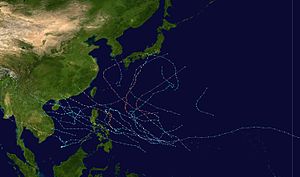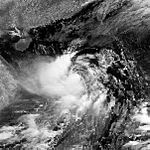1983 Pacific typhoon season
| 1983 Pacific typhoon season |

Season summary map
|
| Seasonal boundaries |
| First system formed |
June 8, 1983 |
| Last system dissipated |
December 19, 1983 |
| Strongest storm |
|
| Name |
Forrest |
| • Maximum winds |
205 km/h (125 mph)
(10-minute sustained) |
| • Lowest pressure |
885 hPa (mbar) |
| Seasonal statistics |
| Total depressions |
33 |
| Total storms |
23 |
| Typhoons |
10 |
| Super typhoons |
4 |
| Total fatalities |
1,073 |
| Total damage |
$258.3 million (1983 USD) |
| Related articles |
|
|
Pacific typhoon seasons
1981, 1982, 1983, 1984, 1985
|
| Tropical storm (JMA) |
| Tropical storm (SSHWS) |
|
|
| Duration |
June 19 – June 26 |
| Peak intensity |
65 km/h (40 mph) (10-min) 999 hPa (mbar) |
| Typhoon (JMA) |
| Category 1 typhoon (SSHWS) |
|
|
| Duration |
July 9 – July 12 |
| Peak intensity |
120 km/h (75 mph) (10-min) 975 hPa (mbar) |
| Typhoon (JMA) |
| Category 2 typhoon (SSHWS) |
|
|
| Duration |
July 12 – July 20 |
| Peak intensity |
140 km/h (85 mph) (10-min) 965 hPa (mbar) |
| Typhoon (JMA) |
| Category 4 super typhoon (SSHWS) |
|
|
| Duration |
July 21 – July 26 |
| Peak intensity |
205 km/h (125 mph) (10-min) 920 hPa (mbar) |
| Typhoon (JMA) |
| Category 5 super typhoon (SSHWS) |
|
|
| Duration |
August 5 – August 18 |
| Peak intensity |
220 km/h (140 mph) (10-min) 895 hPa (mbar) |
| Tropical storm (JMA) |
| Tropical storm (SSHWS) |
|
|
| Duration |
August 8 – August 15 |
| Peak intensity |
75 km/h (45 mph) (10-min) 992 hPa (mbar) |
| Severe tropical storm (JMA) |
| Tropical storm (SSHWS) |
|
|
| Duration |
August 12 – August 15 |
| Peak intensity |
100 km/h (65 mph) (10-min) 985 hPa (mbar) |
| Tropical storm (JMA) |
| Tropical storm (SSHWS) |
|
|
| Duration |
August 17 – August 25 |
| Peak intensity |
75 km/h (45 mph) (10-min) 995 hPa (mbar) |
| Tropical depression (JMA) |
| Tropical depression (SSHWS) |
|
|
| Duration |
August 25 – August 27 |
| Peak intensity |
55 km/h (35 mph) (10-min) 995 hPa (mbar) |
The 1983 Pacific typhoon season has no official bounds, but most tropical cyclones tend to form in the northwestern Pacific Ocean between May and November. These dates conventionally delimit the period of each year when most tropical cyclones form in the northwestern Pacific Ocean. Tropical storms formed in the entire west Pacific basin were assigned a name by the Joint Typhoon Warning Center. Tropical depressions that enter or form in the Philippine area of responsibility are assigned a name by the Philippine Atmospheric, Geophysical and Astronomical Services Administration or PAGASA. This can often result in the same storm having two names.
The season had a late start, as the first system did not form until early June for the first time since 1973. The last tropical cyclone dissipated in mid-December. A total of 26 tropical depressions formed this year in the Western Pacific, of which 23 became tropical storms. Of the 26 tropical cyclones, one formed in June, three formed in July, six formed in August, three formed in September, seven formed in October, five formed in November, and two formed in December. Twelve storms reached typhoon intensity, of which four reached super typhoon strength. Fifteen of the tropical cyclones made landfall, with six moving through the Philippines, six striking China, six moving into Vietnam, and three moving in Japan. Vera, Wayne, Kim, and Lex led to over half of the fatalities from tropical cyclones this season. Forrest became the fastest-developing tropical cyclone on record for the western Pacific Ocean, with a pressure drop of 92 hectopascals (2.7 inHg) in a 24‑hour period.
The season had a late start, as the first system did not form until late June for the first time since 1973. The last tropical cyclone dissipated in mid-December. A total of 26 tropical depressions formed this year in the Western Pacific, of which 23 became tropical storms. Of the 26 tropical cyclones, one formed in June, three formed in July, six formed in August, three formed in September, seven formed in October, five formed in November, and two formed in December. Ten storms reached typhoon intensity, of which four reached super typhoon strength. Fifteen of the tropical cyclones made landfall, with six moving through the Philippines, six striking China, six moving into Vietnam, and three moving in Japan. Tropical cyclones accounted for 24 percent of the annual rainfall in Hong Kong this season.
...
Wikipedia



















